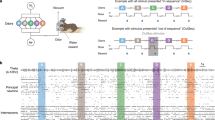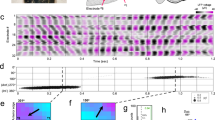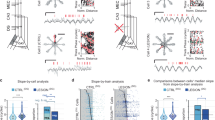Abstract
Exploration, consolidation and planning depend on the generation of sequential state representations. However, these algorithms require disparate forms of sampling dynamics for optimal performance. We theorize how the brain should adapt internally generated sequences for particular cognitive functions and propose a neural mechanism by which this may be accomplished within the entorhinal–hippocampal circuit. Specifically, we demonstrate that the systematic modulation along the medial entorhinal cortex dorsoventral axis of grid population input into the hippocampus facilitates a flexible generative process that can interpolate between qualitatively distinct regimes of sequential hippocampal reactivations. By relating the emergent hippocampal activity patterns drawn from our model to empirical data, we explain and reconcile a diversity of recently observed, but apparently unrelated, phenomena such as generative cycling, diffusive hippocampal reactivations and jumping trajectory events.
This is a preview of subscription content, access via your institution
Access options
Access Nature and 54 other Nature Portfolio journals
Get Nature+, our best-value online-access subscription
$32.99 / 30 days
cancel any time
Subscribe to this journal
Receive 12 print issues and online access
$259.00 per year
only $21.58 per issue
Buy this article
- Purchase on SpringerLink
- Instant access to full article PDF
Prices may be subject to local taxes which are calculated during checkout








Similar content being viewed by others
Data availability
No data was acquired for this study.
Code availability
Simulation code was written using open source packages in the Python 3 programming environment and can be found at https://github.com/dmcnamee/FlexModEHC.
References
Buzsáki, G. & Moser, E. I. Memory, navigation and theta rhythm in the hippocampal-entorhinal system. Nat. Neurosci. 16, 130–138 (2013).
Rowland, D. C., Roudi, Y., Moser, M.-B. & Moser, E. I. Ten years of grid cells. Annu. Rev. Neurosci. 39, 19–40 (2016).
Lisman, J. et al. Viewpoints: how the hippocampus contributes to memory, navigation and cognition. Nat. Neurosci. 20, 1434–1447 (2017).
Ólafsdóttir, H. F., Bush, D. & Barry, C. The role of hippocampal replay in memory and planning. Curr. Biol. 28, R37–R50 (2018).
Foster, D. J. Replay comes of age. Annu. Rev. Neurosci. 40, 581–602 (2017).
Klinzing, J. G., Niethard, N. & Born, J. Mechanisms of systems memory consolidation during sleep. Nat. Neurosci. 22, 1598–1610 (2019).
Pfeiffer, B. E. The content of hippocampal ‘replay’. Hippocampus 30, 6–18 (2020).
Stella, F., Baracskay, P., O'Neill, J. & Csicsvari, J. Hippocampal reactivation of random trajectories resembling Brownian diffusion. Neuron 102, 450–461 (2019).
Pfeiffer, B. E. & Foster, D. J. Hippocampal place-cell sequences depict future paths to remembered goals. Nature 497, 74–79 (2013).
Johnson, A. & Redish, A. Neural ensembles in CA3 transiently encode paths forward of the animal at a decision point. J. Neurosci. 27, 12176–12189 (2007).
Wikenheiser, A. M. & Redish, D. Hippocampal theta sequences reflect current goals. Nat. Neurosci. 18, 289–294 (2015).
Kay, K. et al. Constant sub-second cycling between representations of possible futures in the hippocampus. Cell 180, 552–567 (2020).
Buzsáki, G. & Tingley, D. Space and time: the hippocampus as a sequence generator. Trends Cogn. Sci. 22, 853–869 (2018).
Káli, S. & Dayan, P. Off-line replay maintains declarative memories in a model of hippocampal-neocortical interactions. Nat. Neurosci. 7, 286–294 (2004).
Sanborn, A. & Chater, N. Bayesian brains without probabilities. Trends Cogn. Sci. 20, 883–893 (2016).
Matter, M. G. & Daw, N. D. Prioritized memory access explains planning and hippocampal replay.Nat. Neurosci. 21, 1609–1617 (2018).
Sokal, A. in Functional Integration Vol. 361 (eds DeWitt-Morette, C. et al.) 131–192 (Springer, 1997).
McNaughton, B. L. et al. Deciphering the hippocampal polyglot: the hippocampus as a path integration system. J. Exp. Biol. 199, 173–185 (1996).
Burak, Y. & Fiete, I. R. Accurate path integration in continuous attractor network models of grid cells. PLoS Comput. Biol. 5, e1000291 (2009).
Ocko, S., Hardcastle, K., Giocomo, L. & Ganguli, S. Emergent elasticity in the neural code for space. Proc. Natl Acad. Sci. USA 115, E11798–E11806 (2018).
Bush, D., Barry, C., Manson, D. & Burgess, N. Using grid cells for navigation. Neuron 87, 507–520 (2015).
Behrens, T. et al. What is a cognitive map? Organizing knowledge for flexible behavior. Neuron 100, 490–509 (2018).
Norris, J. Markov Chains (Cambridge Univ. Press, 1997).
Klages, R., Radons, G. & Sokolov, I. M. Anomalous Transport: Foundations and Applications (Wiley, 2008).
McNamee, D. & Wolpert, D. M. Internal models in biological control. Annu. Rev. Control Robot. Auton. Syst. 2, 339–364 (2019).
Weber, M. F. & Frey, E. Master equations and the theory of stochastic path integrals. Rep. Prog. Phys. 80, 046601 (2017).
McNamee, D., Wolpert, D. & Lengyel, M. Efficient state-space modularization for planning: theory, behavioral and neural signatures. Adv. Neural Inf. Process. Syst. 29, 4511–4519 (2016).
Stachenfeld, K., Botvinick, M. & Gershman, S. The hippocampus as a predictive map. Nat. Neurosci. 20, 1643–1653 (2017).
Michelmann, S., Staresina, B. P., Bowman, H. & Hanslmayr, S. Speed of time-compressed forward replay flexibly changes in human episodic memory. Nat. Hum. Behav. 3, 143–154 (2019).
Stensola, H. et al. The entorhinal grid map is discretized. Nature 492, 72–78 (2012).
Barry, C., Ginzberg, L. L., O’Keefe, J. & Burgess, N. Grid cell firing patterns signal environmental novelty by expansion. Proc. Natl Acad. Sci. USA 109, 17687–17692 (2012).
Mallory, C., Hardcastle, K., Bant, J. & Giocomo, L. Grid scale drives the scale and long-term stability of place maps. Nat. Neurosci. 21, 270–282 (2018).
Schlesiger, M. et al. The medial entorhinal cortex is necessary for temporal organization of hippocampal neuronal activity. Nat. Neurosci. 18, 1123–1132 (2015).
Yamamoto, J. & Tonegawa, S. Direct medial entorhinal cortex input to hippocampal CA1 is crucial for extended quiet awake replay. Neuron 96, 217–227.e4 (2017).
Viswanathan, G. M. et al. Optimizing the success of random searches. Nature 401, 911–914 (1999).
Pfeiffer, B. E. & Foster, D. J. Autoassociative dynamics in the generation of sequences of hippocampal place cells. Science 349, 180–184 (2015).
Browne, C. B. et al. A survey of Monte Carlo tree search methods. IEEE Trans. Comput. Intell. AI Games 4, 1–43 (2012).
Colgin, L. et al. Frequency of gamma oscillations routes flow of information in the hippocampus. Nature 462, 353–357 (2009).
Dayan, P. Improving generalization for temporal difference learning: the successor representation. Neural Comput. 5, 613–624 (1993).
Suh, J., Foster, D., Davoudi, H., Wilson, M. & Tonegawa, S. Impaired hippocampal ripple-associated replay in a mouse model of schizophrenia. Neuron 80, 484–493 (2013).
Karlsson, M. & Frank, L. Awake replay of remote experiences in the hippocampus. Nat. Neurosci. 12, 913–918 (2009).
Wikenheiser, A. M. & Redish, A. D. Decoding the cognitive map: ensemble hippocampal sequences and decision making. Curr. Opin. Neurobiol. 32, 8–15 (2015).
Gershman, S. J., Horvitz, E. J. & Tenenbaum, J. B. Computational rationality: a converging paradigm for intelligence in brains, minds, and machines. Science 349, 273–278 (2015).
Lieder, F., Griffiths, T. & Hsu, M. Overrepresentation of extreme events in decision making reflects rational use of cognitive resources. Psychological Rev. 125, 1–32 (2018).
Kang, L. & DeWeese, M. Replay as wavefronts and theta sequences as bump oscillations in a grid cell attractor network. eLife 8, e46351 (2019).
Witter, M. P., Canto, C. B., Couey, J. J., Koganezawa, N. & O'Reilly, K. C. Architecture of spatial circuits in the hippocampal region. Philos. Trans. R. Soc. B Biol. Sci. 369, 20120515 (2014).
Lisman, J. E. & Jensen, O. The theta-gamma neural code. Neuron 77, 1002–1016 (2013).
Hills, T. et al. Exploration versus exploitation in space, mind, and society. Trends Cogn. Sci. 19, 46–54 (2015).
Botvinick, M. M., Niv, Y. & Barto, A. C. Hierarchically organized behavior and its neural foundations: a reinforcement learning perspective. Cognition 113, 262–280 (2009).
Schapiro, A., Rogers, T., Cordova, N., Turk-Browne, N. & Botvinick, M. Neural representations of events arise from temporal community structure. Nat. Neurosci. 16, 486–492 (2013).
Sutton, R. & Barto, A. Reinforcement Learning: An Introduction (MIT Press, 2018).
Cover, T. & Thomas, J. Elements of Information Theory (Wiley, 2006).
Viswanathan, G. M., Da Luz, M. G., Raposo, E. P. & Stanley, H. E. The Physics of Foraging: An Introduction to Random Searches and Biological Encounters (Cambridge Univ. Press, 2011).
Jinnai, Y., Park, J. W., Abel, D. & Konidaris, G. Discovering options for exploration by minimizing cover time. Preprint at arXiv:1903.00606 (2019).
Acknowledgements
This work was supported by the Center for Brains, Minds and Machines (funded by NSF STC award no. CCF-1231216) and the Wellcome Trust (Sir Henry Wellcome Fellowship grant no. 110257/Z/15/Z to D.C.M.). For the purpose of Open Access, we have applied a CC BY public copyright licence to any Author Accepted Manuscript version arising from this submission. We thank A. Bernacchia, Q. Huys, Z. Kurth-Nelson, M. Nour, E. Russek, H. Sheahan, H. Stojic, S. Tootoonian and E. Wimmer for discussions and feedback. We thank F. Stella and J. Csicsvari (IST Austria) for sharing their data and for performing additional analyses. We thank B. Sorscher and colleagues (Stanford University) for sharing their code.
Author information
Authors and Affiliations
Contributions
D.C.M., K.L.S., M.M.B. and S.J.G. contributed toward model conceptualization. D.C.M. performed the simulations. D.C.M. prepared a draft of the manuscript. D.C.M., K.L.S., M.M.B. and S.J.G. reviewed the manuscript contributing edits and comments.
Corresponding author
Ethics declarations
Competing interests
D.C.M. and S.J.G. declare no competing interests. K.L.S. and M.M.B. are employed by Google DeepMind.
Additional information
Peer review information Nature Neuroscience thanks Sen Cheng, Kiah Hardcastle and Martin Stemmler for their contribution to the peer review of this work.
Publisher’s note Springer Nature remains neutral with regard to jurisdictional claims in published maps and institutional affiliations.
Extended data
Extended Data Fig. 1 Sequence generation in an inhomogeneous environment with tempo τ and stability α modulation.
a, Spectral components of the four-room grid world are presented as a function of spatial scale. Generator eigenvectors coincide with the eigenvectors of the corresponding SR. Therefore, many examples of generator eigenvectors may be observed in ref. 28. b, As the tempo parameter τ is reduced (with the stability parameter held at α = 1), the power spectrum sτ,α(λ) reweights the spectral components leading to changes in the spatial scale of the propagation densities ρt. c, The generated sequences vary in the extent of their spatiotemporal traversal of the environment.
Extended Data Fig. 3 Propagator analysis across all possible current and future positions for the circular track task.
a,b, We plot the superdiffusive (panel A, α = 0.5) and diffusive propagators (panel B, α = 1) for the circular track task11 for all current positions (y-axis) with all goals activated. The y-axis (x-axis) indexes the current (future) position. Each row reports the probability of each position being sampled given the current position (the row index). c, The difference in diffusive and superdiffusive propagators is plotted. For example, the row corresponding to the initial X position (marked by the thick black line), shows that the local activations are less likely (red) under superdiffusions compared to diffusion (though they are still possible) while remote goal locations specifically are more likely (blue).
Extended Data Fig. 4 Diffusions are optimized for consolidating directed transition structures.
Three regimes of sequence generation are compared in terms of consolidating a directed policy on the same graph used in Fig. 7 where the policy was assumed to be undirected (that is a random walk). a, The directed policy is dominated by high probability anticlockwise transitions (heavy black arrows) between the clique bottleneck states (highlighted by increased size). Within each clique, transitions to the bottleneck state facilitating an anti-clockwise transition to the next clique are relatively likely to occur. b, The same rank order as in Fig. 7c is observed with the diffusive regime leading to the most accurate consolidation of the directed policy successor representation (SR). c, The true directed policy SR. d–f, The SRs learned via superdiffusion, diffusion, and minimally autocorrelated sampling respectively. Note that the superdiffusive and minimal autocorrelation regimes identify the the dominant anti-clockwise transition structure but fail to reflect the clustering of states based on their clique membership. This simulation indicates that the diffusive regime is optimal for consolidation regardless of whether the target transition structure corresponds to a random walk or not.
Extended Data Fig. 5 Detailed analyses of spectrally modulated propagation in the linear track environment.
a, Copy of Fig. 2d for context and comparative visualization. b, The propagation distributions in panel A are re-expressed as the difference with respect to the baseline (τ = 1, α = 1). c, Each propagation density is plotted against the baseline propagation density (τ = 1, α = 1) on log scales. Note that only superdiffusion results in a non-linear warping of the propagation density. This non-linearity underpins the heavy-tail in the propagation density. d, Small-scale (dashed line) and large-scale (full line) spectral components (that is, generator eigenvectors) are plotted as a function of linear track position. Eigenvalues take a maximum value of 0 and are ordered according to the spatial scale of the corresponding spectral component. For example, eigenvalues close to zero correspond to large-scale spectral components with the spatial scale of the corresponding spectral component decreasing with the eigenvalue which are always less than or equal to zero. Therefore, the scale of a spectral component ϕk decreases as the absolute value |λk| of its corresponding eigenvalue λk increases. e, Spectral power is plotted as a function of eigenvalue on a log scale. As the tempo τ decreases towards zero, the spatiotemporal horizon increases and the propagation density converges on the stationary state distribution. This corresponds to all spectral components with non-zero eigenvalues decaying to zero. Note that diffusion linearly changes the slope of the power spectrum while superdiffusion imposes a non-linear reweighting. This effect underpins the nonlinear time warping in the propagation densities in panel C. f, The characteristic modulation of the power spectrum under diffusion and superdiffusion is demonstrated by the relative power spectrum \(\frac{{s_{\tau ,\alpha }(\lambda )}}{{s_{1,1}(\lambda )}}\) computed as the power ratio with respect to the baseline propagator. Note that the long-range diffusion propagator (α = 1, τ = 0.5, thick red line) downweights small-scale components and upweights large-scale components while superdiffusion (α = 0.5, τ = 1, thick blue line) relatively upweights both small- and large-scale components but suppresses at medium scales. This enables a superdiffusive propagator to jump to remote positions without traversing intermediate locations.
Extended Data Fig. 6 Mean displacement scales linearly on a log-log plot.
The data and simulations from Fig. 6 are plotted on a logarithmic scales demonstrating the linear relationship between mean spatial displacement and time intervals. Mean displacement (MD) measures the ratio between the spatial displacement and time interval of sequence generation and can be used to infer whether a generative sampling process is operating in a diffusive or superdiffusive regime based on sampled sequences. In particular, the MD function has a slope proportional to α−1 with respect to the time interval Δt (Methods). Error bars ± s.e.m..
Extended Data Fig. 7 Sampled sequences exhibit distinctive patterns across spectral modulation regimes.
Each column shows five sample sequences generated in one of the three sampling regimes studied in Fig. 7. Note that diffusions (left column) tend to remain within a single clique. Superdiffusions (middle column) interleave local diffusions with occasional jumps to other cliques. Jumps are observed as lines crossing the center of the ring which do not conform to any transition step in the underlying state-space structure (gray lines). Minimally autocorrelating propagators (right column) repeatedly generate large jumps between cliques.
Supplementary information
Supplementary Information
Supplementary Math Note.
Rights and permissions
About this article
Cite this article
McNamee, D.C., Stachenfeld, K.L., Botvinick, M.M. et al. Flexible modulation of sequence generation in the entorhinal–hippocampal system. Nat Neurosci 24, 851–862 (2021). https://doi.org/10.1038/s41593-021-00831-7
Received:
Accepted:
Published:
Issue date:
DOI: https://doi.org/10.1038/s41593-021-00831-7
This article is cited by
-
Distributed and dynamical communication: a mechanism for flexible cortico-cortical interactions and its functional roles in visual attention
Communications Biology (2024)
-
Neural network based formation of cognitive maps of semantic spaces and the putative emergence of abstract concepts
Scientific Reports (2023)
-
How to build a cognitive map
Nature Neuroscience (2022)
-
Decoding cognition from spontaneous neural activity
Nature Reviews Neuroscience (2022)
-
Neural network based successor representations to form cognitive maps of space and language
Scientific Reports (2022)



